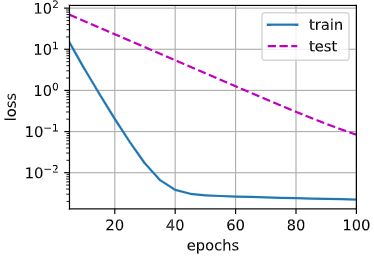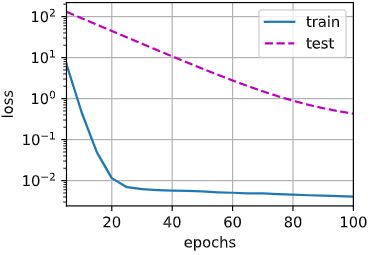【动手学深度学习】(六)权重衰退
文章目录
- 一、理论知识
- 二、代码实现
-
- 2.1从零开始实现
- 2.2简洁实现
- 【相关总结】
主要解决过拟合
一、理论知识
1、使用均方范数作为硬性限制(不常用)
通过限制参数值的选择范围来控制模型容量

通常不限制偏移b
小的![]() 意味着更强的正则项
意味着更强的正则项
使用均方范数作为柔性限制
对于每个![]() 都可以找到
都可以找到![]() 使得之前的目标函数等价于下面的:
使得之前的目标函数等价于下面的:

- 权重衰退通过L2正则项使得模型参数不会过大,从而控制模型复杂度
- 正则项权重是控制模型复杂度的超参数
二、代码实现
权重衰减是最广泛使用的正则化技术之一
1.首先,人工生成数据

我们选择标签是关于输入的线性函数。 标签同时被均值为0,标准差为0.01高斯噪声破坏。 为了使过拟合的效果更加明显,我们可以将问题的维数增加到, 并使用一个只包含20个样本的小训练集。
%matplotlib inline
import torch
from torch import nn
from d2l import torch as d2l
n_train, n_test, num_inputs, batch_size = 20, 100, 200, 5
true_w, true_b = torch.ones((num_inputs, 1)) * 0.01, 0.05
# print(torch.ones((num_inputs, 1)))
# print(true_w)
train_data = d2l.synthetic_data(true_w, true_b, n_train)
train_iter = d2l.load_array(train_data, batch_size)
# print(train_iter)
test_data = d2l.synthetic_data(true_w, true_b, n_test)
test_iter = d2l.load_array(test_data, batch_size, is_train=False)
2.1从零开始实现
只需将的平方惩罚添加到原始目标函数中。
def init_params():
w = torch.normal(0, 1, size=(num_inputs, 1), requires_grad=True)
b = torch.zeros(1, requires_grad=True)
return [w,b]
定义L2范数惩罚
def l2_penalty(w):
return torch.sum(w.pow(2)) / 2
定义训练代码
def train(lambd):
w,b = init_params()
net, loss = lambda X: d2l.linreg(X, w, b), d2l.squared_loss
num_epochs, lr = 100, 0.003
animator = d2l.Animator(xlabel='epochs', ylabel='loss', yscale='log',
xlim=[5,num_epochs], legend=['train', 'test'])
for epoch in range(num_epochs):
for X, y in train_iter:
# 增加了L2范数惩罚项
# 广播机制使l2_penalty(w)成为一个长度为torch_size的向量
l = loss(net(X), y) + lambd * l2_penalty(w)
l.sum().backward()
d2l.sgd([w,b], lr, batch_size)
if(epoch + 1) % 5 == 0:
animator.add(epoch + 1, (d2l.evaluate_loss(net, train_iter, loss),
d2l.evaluate_loss(net, test_iter, loss)))
print('w的L2范数是:',torch.norm(w).item())
忽略正则化直接训练
用lambd = 0禁用权重衰减
train(lambd=0)
w的L2范数是: 13.702591896057129

使用权重衰退
train(lambd=3)
2.2简洁实现
在实例化优化器时直接通过weight_decay指定weight decay超参数
def train_concise(wd):
net = nn.Sequential(nn.Linear(num_inputs, 1))
for param in net.parameters():
param.data.normal_()
loss = nn.MSELoss(reduction='none')
num_epochs, lr = 100, 0.003
# 偏置参数没有衰减
trainer = torch.optim.SGD([
{"params":net[0].weight,'weight_decay': wd},
{"params":net[0].bias}], lr=lr)
animator = d2l.Animator(xlabel='epochs', ylabel='loss', yscale='log',
xlim=[5, num_epochs], legend=['train', 'test'])
for epoch in range(num_epochs):
for X, y in train_iter:
trainer.zero_grad()
l = loss(net(X), y)
l.mean().backward()
trainer.step()
if (epoch + 1) % 5 == 0:
animator.add(epoch + 1,
(d2l.evaluate_loss(net, train_iter, loss),
d2l.evaluate_loss(net, test_iter, loss)))
print('w的L2范数:', net[0].weight.norm().item())
train_concise(0)
train_concise(3)





